Pet Costumes & Staging Human-Animal Relations
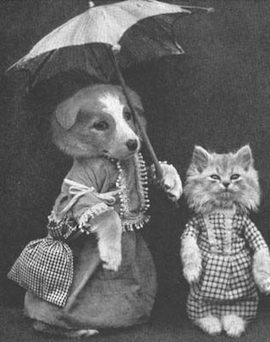
from buzzfeed.com
In his 2010 text, Developing Animals: Wildlife and Early American Photography, Matthew Brower considers the constructed nature of wildlife photography and what it tells us about historical understandings of human-animal relations. Brower is the curator of the University of Toronto Art Centre and a lecturer in museum studies in the Faculty of Information at the University of Toronto. Beginning with an analysis of early American photographs of taxidermy, his text examines the practice of “camera hunting” in the nineteenth century, the invention of the photographic blind and Abbott Thayer’s use of photographs to make arguments about animal coloration and camouflage. Brower argues that examining these photographic practices illustrates how they construct a particular narrative of the relationship between animals and humans. Brower suggests that photos of perceived “wild animals” are staged to tell a particular story about the historical constitution of the animal and human-animal interaction.
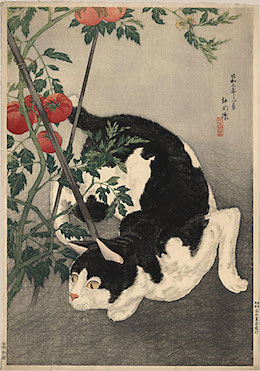
photo credit: Blanton Musuem of Art: Takahashi Hiroaki (Shotei), Published by Fusui Gabo
Cat Prowling Around a Staked Tomato Plant, 1931
The Blanton Museum of Art’s recent exhibit “In the Company of Cats and Dogs” (June-September 2014) presented similar conclusions about the historical and contemporary presence of canines and felines in art. The exhibit illustrated how representations of domestic animals tell stories about how humans perceive themselves and their environments. One of my favorite sections was a grouping of paintings that pictured cats as causing and representing social deviance among their human companions, and spoke to a fear of female pleasure and independence.
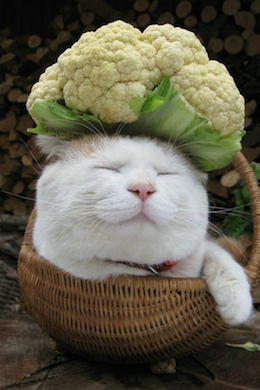
from tonsofcats.com
One of the more popular pieces seemed to be a flat-screen television mounted on the wall playing a circuit of images of the Japanese, internet-famous cat Shironeko (“White Cat”), also known as “Basket Cat” or “Zen Cat.” This cat (sometimes along with other cats) is pictured in a relaxed-state with various kinds of vegetables and baskets balanced on his head and body. Shironeko is costumed, but not to represent anything other than the work of art that he himself has become. The use of organic materials in these photographs allows the scene to seem wild, or of nature, despite the obvious and heavy-handed human intervention. These photographs also emphasize the cat’s “natural” relaxed state, while simultaneously underscoring a human presence by juxtaposing the cat’s body with something unexpected and disruptive.
The photography of costumed pet stages a particular story of anthropomorphism, providing a narrative of human-animal, or child-animal, proximity and cohabitation. Now that access to photography and sharing images is open to most people, some of the seemingly most popular photos shared are of domestic animals. This becomes particularly obvious around Halloween when photos of clothed pets proliferate, as many pop culture media outlets are posting lists of the “silliest,” “greatest EVER,” or “funniest” photos of pets in costume. They seem more popular than photos of costumed kids (at least my internet bubble). What do the photographs of these costumed pets say about our staged relationship with domesticated animals?
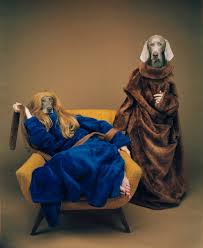
Mother/Daughter, 1994/2009 from panopticangallery.com
One of the more well-known contemporary animal photographers, William Wegman, takes series of photos of Weimaraners, often wearing human clothing or interacting with objects. While not much art criticism exists on his work [the art critic Eric Banks wrote in ArtForum that Wegman has “marketed himself and his canine celebrities so well (and so outside the precincts of contemporary art) that it’s hard to formulate a critical take,”] Wegman’s photographs have been lauded in popular media and are so popular that his dog Man Ray was named “Man of the Year” by The Village Voice in 1982. In a 2011 article in the Smithsonian Magazine David Schonauer suggests that Wegman’s use of these dogs allows him to point out the absurdity of human ambition; he writes that Wegman “punctures [the dogs’] regal bearing by surrounding the animals with absurd artifacts from everyday human life,” that allows him to make fun of “our shaky human ambitions…not the dogs.” I agree and add that his photos of the dogs’ stable, blank stares directly address, and attempt to render absurd, our tendencies to try to read human emotions on our domestic pets.

Dog Walker, 1990 from wegmanworld.typepad.com
How does amateur photography of pets in costume compare to Wegman’s work? It seems that there are those that follow Wegman’s lead and point out the very absurdity present in dressing pets. What’s funny about these types of costumed pet photos is the very fact that we’re looking at a costumed pet.
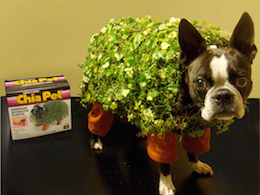
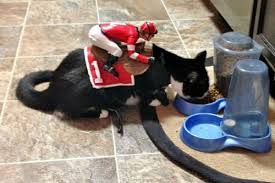
from Buzzfeed
On the other hand, there are costumes that attempt to humanize the animal with a bit less irony. The best ones of these often picture the human companion right alongside the pet, drawing attention to a relationship of equity and proximity—we’re all trying to be someone else.
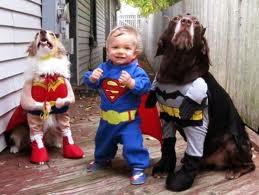
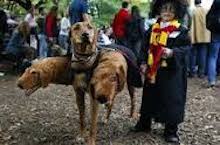
from Buzzfeed
There are also lots of debates out on the internet about the ethics of costuming pets. [For example, a costumed dog may actually feel physically shamed without having any awareness of how s/he looks, since the costume’s position may mimic another dog dominating!] The Humane Society and other animal rights groups put out a list of best practices when dressing up pets to avoid harming them, since sometimes people’s enthusiasm to costume prevents their pet from properly breathing or perspiring. And most animal rights organizations have embraced pet photography of all kinds as a way to draw in support and empathy for animals.
Dressing our pets in costume around Halloween, even if done to merely highlight the absurdity of the costumed pet and get a laugh, nevertheless encourages us to read these pets as part of the community, as participating in a holiday ritual of temporarily becoming something else, even if what they actually end up representing is mostly their perceived proximity to us. While Brower reads wildlife photos as staged to present “real animals” as those that only exist in human and cultural absence, the photography of domesticated animals in costume illustrates their perceived role as contributing members of our culture. His reading is useful in its emphasis that the staging of these photos is entirely about us.



Add new comment